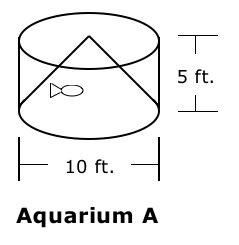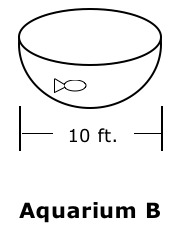Use Cavalieri’s Principle to Compare Aquarium Volumes
The management of an ocean life museum will choose to include either Aquarium A or Aquarium B in a new exhibit.
Aquarium A is a right cylinder with a diameter of 10 feet and a height of 5 feet. Covering the lower base of Aquarium A is an “underwater mountain” in the shape of a 5-foot-tall right cone. This aquarium would be built into a pillar in the center of the exhibit room.
Aquarium B is half of a 10-foot-diameter sphere. This aquarium would protrude from the ceiling of the exhibit room.


How many cubic feet of water will Aquarium A hold?
For each aquarium, what is the area of the water’s surface when filled to a height of $h$ feet?
Use your results from parts (a) and (b) and Cavalieri's principle to find the volume of Aquarium B.




